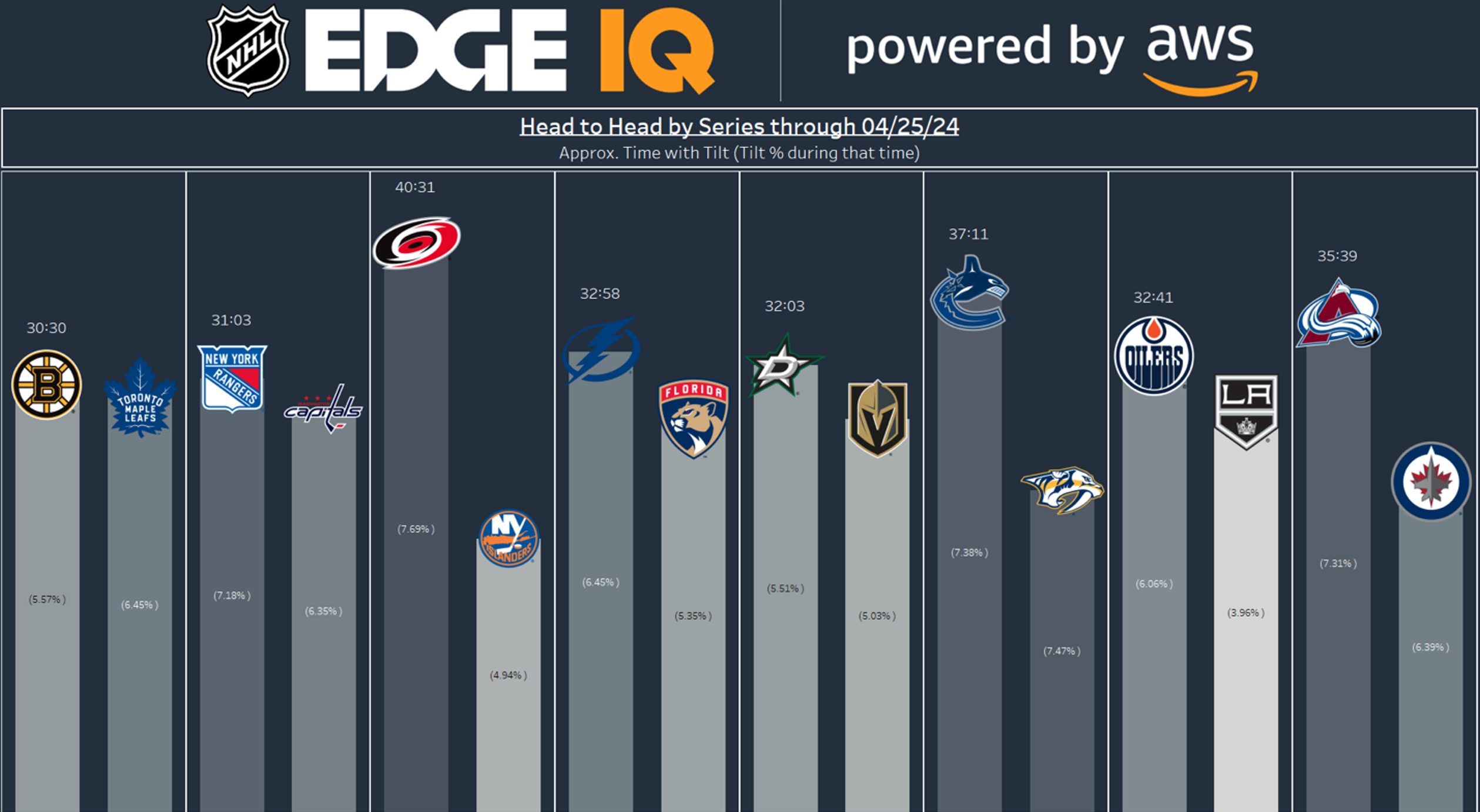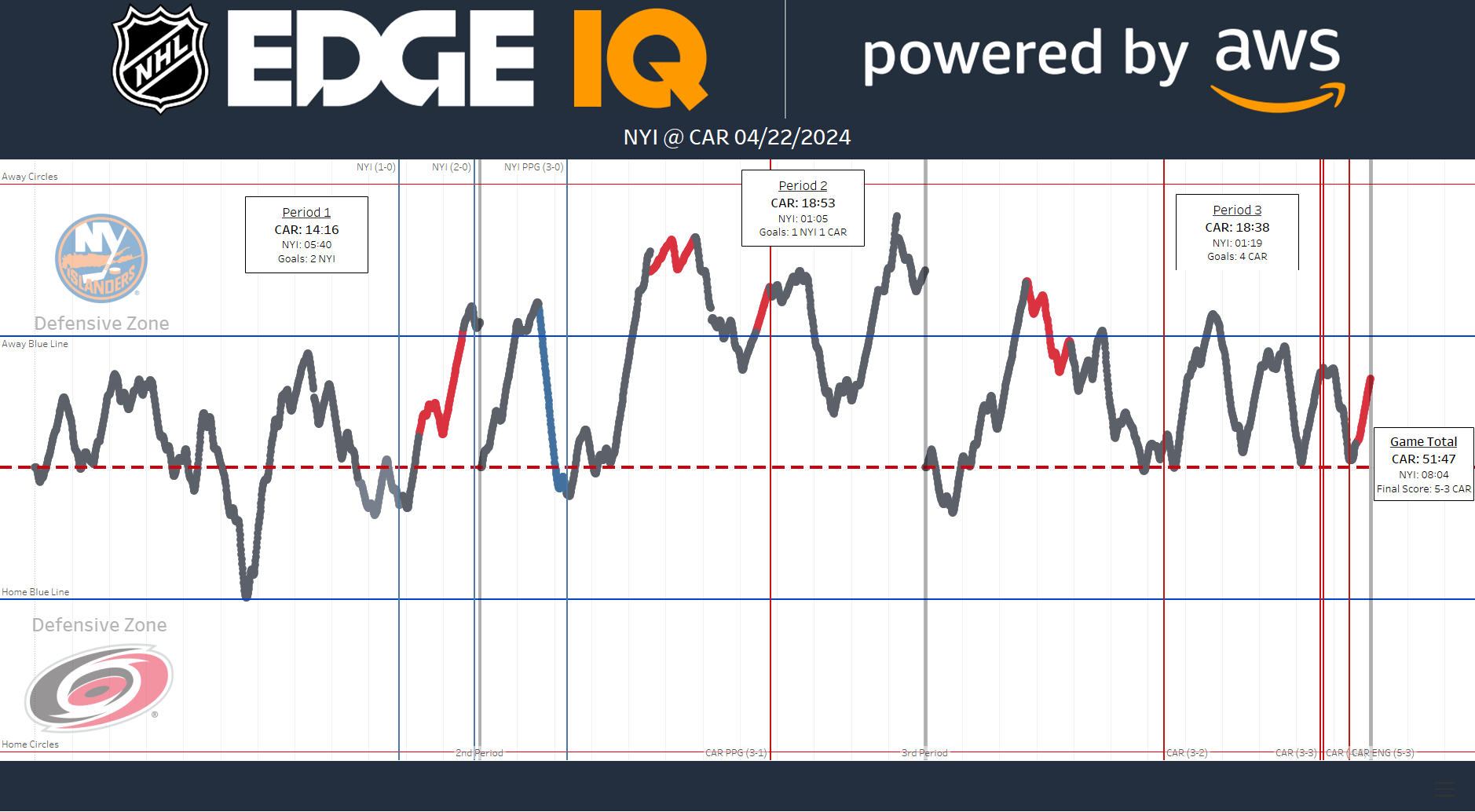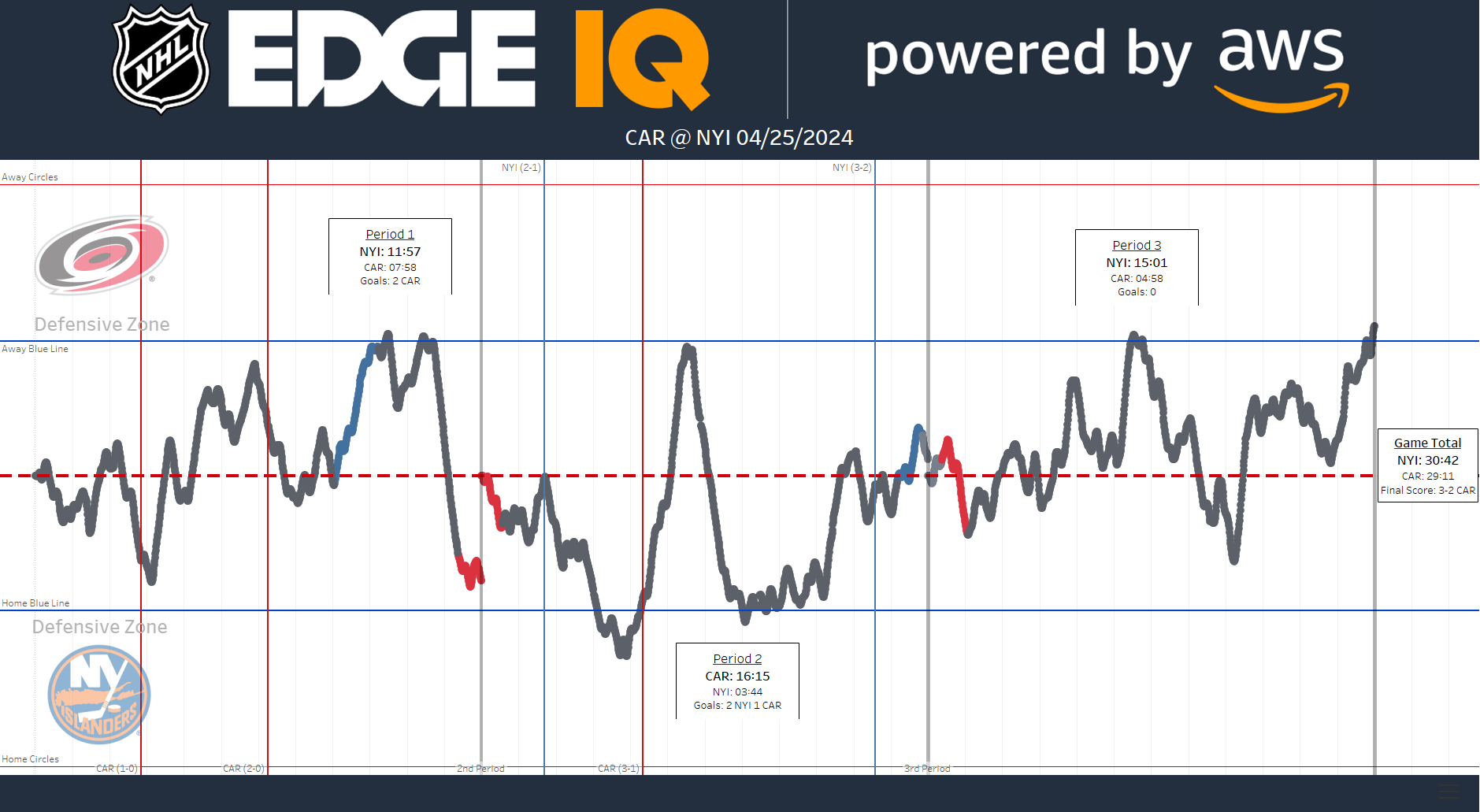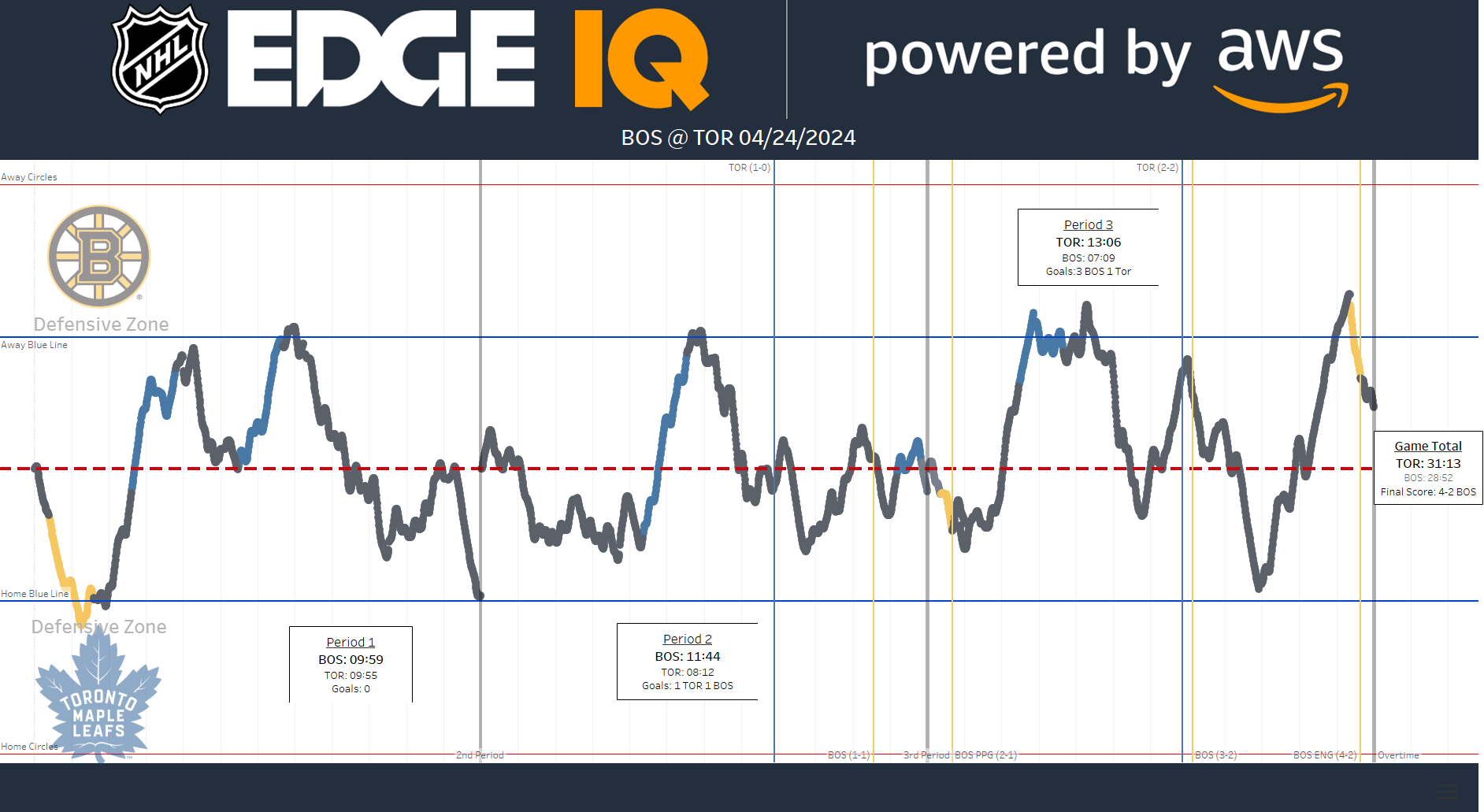As you’ve likely noticed, “Ice Tilt” has become something of a fixture in our present-day hockey lexicon, usually in regards to a player or line.
“Every time that Svechnikov line is out there they tilt the ice towards the Islanders end” is a not-so-random example of how the phrase is used.
Teams strive for multiple shifts of "good tilt" in a row to build momentum. We’ve heard coaches talk about dominating a shift, changing in the offensive zone and getting fresh legs out there so you get the defensive team diving into their own bench to get off the ice. That's usually when teams score, or at least when they create good chances.
Speaking of Carolina/New York, just listen to the commentator on this play when the Islanders are exhausted, hemmed in, and Carolina is toying with them like a cat does a mouse.
At that point, the score is 3-1 New York in Game 2, but as we now know the heavy tilt of the rink in Carolina’s favour ends up with the Hurricanes coming back for a 5-3 win.
I wrote about the concept of Ice Tilt last week, the latest analytic from NHL EDGE IQ powered by AWS, and how the NHL has used the chips in player sweaters to measure where the 10 skaters and two goaltenders are on the rink at any given time, and give us a look at momentum swings in a game.
It looks at “where is the game really being played?” I explained the concept more in-depth here if you’d like further background on how it’s actually calculated.
What I like about Ice Tilt as a metric is its relationship to a now-common statistic in hockey, Corsi.
Jim Corsi was the goaltender coach for the Buffalo Sabres when he hit on a pretty basic concept. A goaltender’s workload wasn’t just about how many shots the opposing team got on net, it was how many shots they attempted. Each time there’s a shot attempt, a goalie goes through the work of pushing out to the right angle, getting set and reacting, and their positioning often influences the location of the shot. That means whether the shot hit the post, missed the net, was blocked or got through, a goalie has to do just about the same amount of work. This measure of shot attempts – now known as “Corsi” – measured workload.
We now use “Corsi” to highlight which team is carrying the play in a game, and Ice Tilt takes it a step further. When a team has the puck in your defensive zone, your players still have to do stops and starts, finish checks, and compete in puck battles. It’s hard work. Whether the opposing team gets a shot attempt or not, where the play is located can affect how a team feels.
Ice Tilt is a picture of where the play has been located, which can help give context to outcomes. Play a lot in the offensive zone and you’re more likely to get a “lucky” bounce that goes in your team’s favour.
We’re now halfway through the first round of the Stanley Cup Playoffs, so I thought it would be fun to look at Ice Tilt for each series. The numbers are per-game averages so far, and I’ll get more into the other numbers on the graph in a minute. Check it out below. That Canes/Isles series is far and away the most lopsided (which I predicted pre-series!), with Carolina tilting the ice for over two-thirds of game play.

The closest series to date is Toronto/Boston, which will add up for anyone who’s watched those three games.
An advanced detail for fans who want to know more about this: The percentage number on the bars tells us the amount of tilt these teams have had past centre ice, when they’ve had tilt. Consider it “quality” while the raw time is “quantity.” Since we’re measuring the average location of the five skaters and goalie at any given time, it's showing how far past the centre red a team has pushed on average towards the opposing goal when they’ve had momentum. For clarity, I like to add 50 per cent -- the other half of the rink -- so a team shown to have six per cent tilt on this graph has on average played 56 per cent up-ice from their own goal.
The simpler info is “the higher the percentage, the deeper a team is playing in the offensive zone.” Again, more details on the how it’s calculated here.
I like checking Ice Tilt because it helps me understand a game’s story, which doesn’t always confirm what my eyes have told me.
I knew the Islanders got outplayed in Game 2, when they blew a 3-0 lead, but woof. The momentum chart is one of the most lopsided games I’ve ever seen.

Carolina spent 51:47 on the Islanders' half of the red line(!!!), which I cannot use enough exclamation marks to explain how crazy it is. Let’s go a little more in-depth on that insane peak on the graph.
Tilt percentage at that point is 26.8 per cent, which combined with the other half of the ice means Carolina pushed up an average of 76.8 per cent from their end. For context of where that is on the ice, that means Carolina was nearly 50 feet past centre ice (the blue line is just 25 feet from centre), and nearly 140 feet from their own net from 3:16 to 1:16 on the game clock. It wasn’t a power play.
In terms of Ice Tilt, the rink was a see-saw, and the only people on it were the Islanders who were all on the same side.
In Game 3 the Isles were far better in a 3-2 loss, but just didn’t get the saves and finishing they needed for the win. Here, Ice Tilt helps us understand that although shots were heavily in New York's favour -- 31-22 -- the game was at least close enough to be a coin toss. You can see the Isles' big push in the second after Carolina scored.

This graph looks closer to most playoff games. You get big pushes from one team, the score dictates some of the late-game pushes, and often stretches of momentum result in a goal.
As someone closely following the Leafs/Bruins series, you can see the story of Game 3 through its line graph. It shows how the Leafs responded to an early Boston goal in the third period and pushed hard to get one back, which they eventually made happen.

But when Boston immediately answered, it sucked the life out of the building for a while, and the Bruins hung on until the end.
Throughout playoffs we’ll be checking in on Ice Tilt, and taking a closer look at which teams have dominated their series, and forecasting what that means for potential future matchups.
Right now the Canes are the undisputed play-driving kings. If they get good goaltending and can put a few pucks away, they look like a tough out in the East.







